Cascadia Research is involved in two field projects in Hawai‘i this October. Starting on October 2nd Cascadia Research biologist Daniel Webster joined a field project off O‘ahu working with researchers from the Pacific Islands Fisheries Science Center, for a 16-day effort. And from October 19-31 we will be undertaking research off the island of Hawai‘i (the “Big Island”). This work is being funded by the Pacific Islands Fisheries Science Center and the Southwest Fisheries Science Center (with support from the U.S. Navy). Off the island of Hawai‘i the research team includes Greg Schorr, Daniel Webster and Robin Baird of Cascadia, Dan McSweeney of the Wild Whale Research Foundation, Erin Oleson of the Pacific Islands Fisheries Science Center, and a number of volunteers. Our primary goals for this project are to examine movement patterns and habitat use of false killer whales and beaked whales (through the deployment of satellite tags)
Like all of our field projects, we also have a number of additional goals:
- Collection of blubber samples from biopsies of false killer whales and short-finned pilot whales, for a collaborative study on persistent organic pollutants of these species, with the Northwest Fisheries Science Center.
- Recover and re-deploy a High-frequency Acoustic Recording Package (HARP), used to monitor presence of cetaceans off Kona by recording species-specific sounds.
- Collection of skin/blubber samples from biopsies and from suction-cups for examination of stock structure (in collaboration with Susan Chivers and Karen Martien of the Southwest Fisheries Science Center, and Sarah Courbis of Portland State University) and trophic ecology (in collaboration with Jason Turner of the University of Hawai‘i, Hilo)
- Collection of fecal samples to examine diet (a collaborative project with Mike Ford of the Northwest Fisheries Science Center, Seattle)
- Photo-identification of 10 species of odontocetes to examine residency/movements
- Collection of survey and sighting data for examination of habitat use
- Collecting dead cephalopods to assess potential prey of deep-diving odontocetes, in collaboration with Bill Walker at the National Marine Mammal Laboratory
For more information see our Hawai‘i odontocete research page
Most recent updates are at the top of the page.
November 30 update
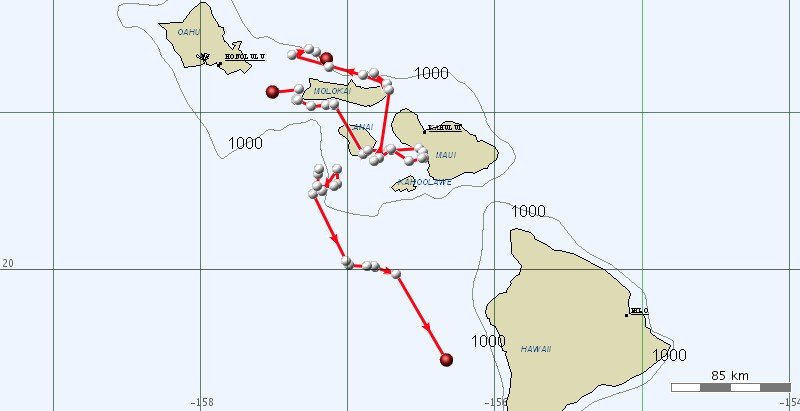
We are still getting daily locations of three of the five Pseudorca tagged in October – the above map shows locations through the morning of November 30th for a two-day period. Our next project starts on December 8th – check our update page for that project for more information.
October 31 update
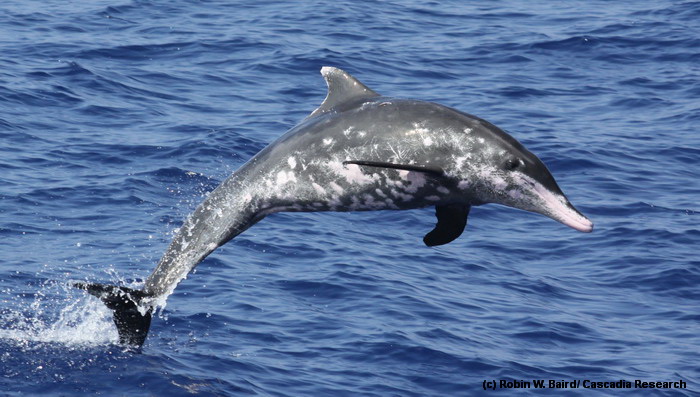
A leaping Steno, October 31. Photo by Robin Baird.
Our last day on the water for this trip. In 13 days on the water we covered almost 1,800 kilometers and 39 sightings of 11 species of odontocetes (no baleen whales to be seen). On our last day we encountered our second group of rough-toothed dolphins (see above), our fifth group of bottlenose dolpins, our eighth group of pilot whales, and our 11th group of pantropical spotted dolphins. We collected a couple of additional biopsy samples, photo-Id’d all of the pilot whales and bottlenose dolphins and most of the rough-toothed dolphins, and also deployed on additional satellite/dive tag on a pilot whale.
We are still getting satellite locations from the Cuvier’s beaked whale and four of the Pseudorca and will post occassional maps of their movements here.
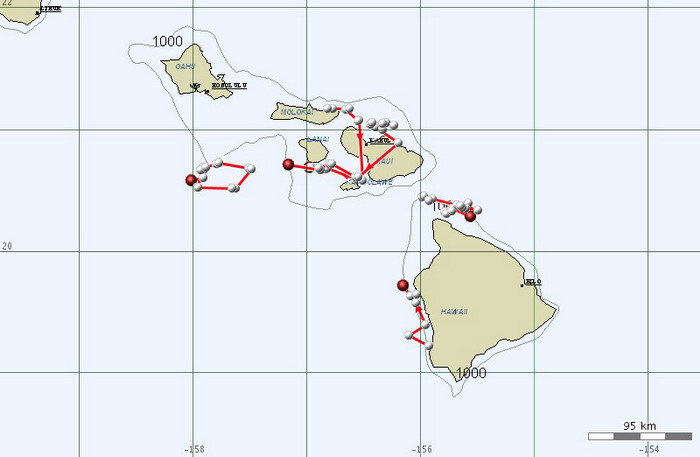
Map showing movements of the four tagged Pseudorca and the one tagged Cuvier’s beaked whale (the southern-most individual) from the evening of October 30th through the morning of November 1st.
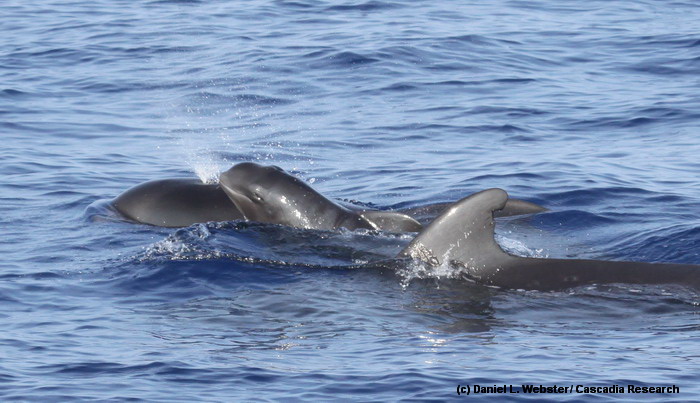
A newborn pilot whale, October 31. Photo by Daniel Webster. The fetal folds can be seen on the side of this newborn, and the high out of the water surfacing is also characteristic of a newborn.
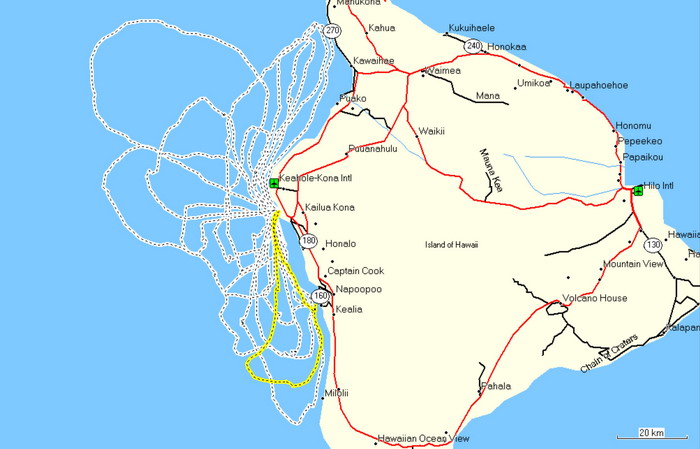
Our final trackline for this field project, with today’s effort highlighted in yellow.
October 30 update

A mother and newborn dwarf sperm whale (Kogia sima), October 30. Photo by Robin Baird. When first seen the calf was separated from its mother by about 60 meters, was acting very uncoordinated in its surfacing and appeared to have a bent over dorsal fin, indicating it had probably just been born. The female, HIKs020 in our photo-identification catalog, has been previously documented in the area in 2004, 2006, and twice in 2008.
October 29 update
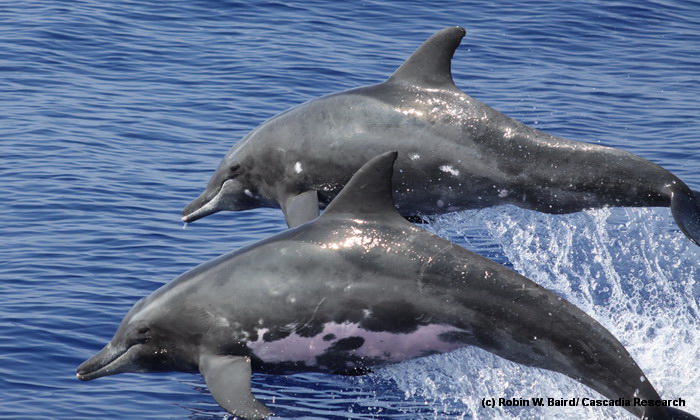
A pair of rough-toothed dolphins leaping, October 29. Photo by Robin Baird.
Our 11th day on the water. Although the satellite tagged Pseudorca remained just outside of our study area for another day, we did encounter our 10th, and 11th, species of cetaceans for the trip. South of Miloli‘i we encountered a fairly large group (~26) of rough-toothed dolphins (locally known as Steno). We were able to photo-identify most of the individuals present, and also collected five biopsy samples for genetics and toxicology.
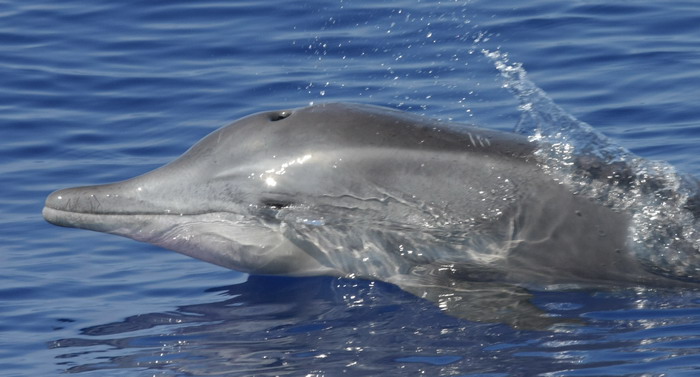
A juvenile rough-toothed dolphin, October 29. Photo by Jessica Aschettino.

Our trackline from October 29 is highlighted in yellow.
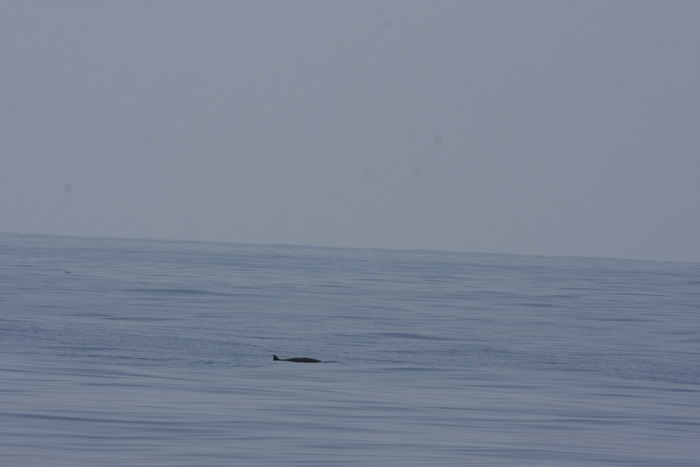
Based on photos on this page you might get the (mistaken) impression that all of our sightings are close up with cooperative animals, but the above photo (a distant beaked whale, photo by Jessica Aschettino) is typical of many of our sightings. For beaked whales we take photos at any distance, since many sightings are brief and with distant photos we are often able to confirm species.
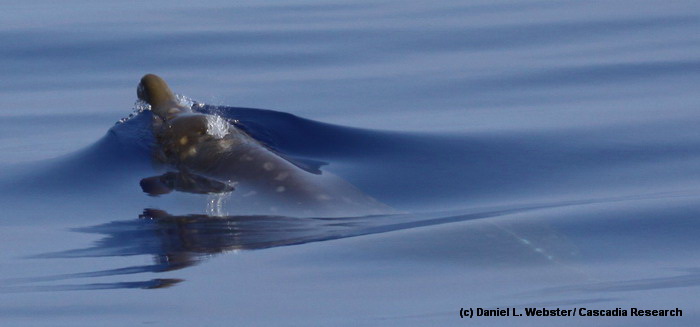
In this case with calm seas and the whales only diving for 10-20 minutes we were able to approach close enough to obtain good identification photos, but not close enough for satellite tagging. A Blainville’s beaked whale, October 29. Photo by Daniel Webster. This individual is an adult female, based on the number of white oval scars which accumulate with age (from cookie-cutter sharks), and the lack of erupted teeth in the lower jaw. The other individual present in this encounter was an adult male.
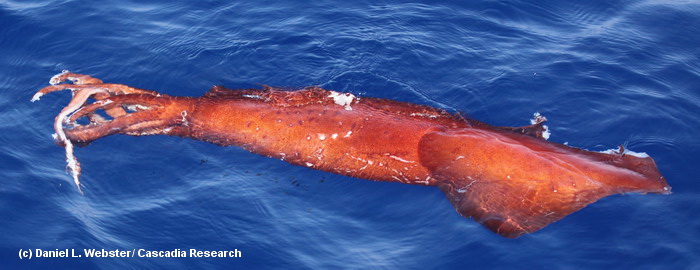
Our fourth squid collected this trip, a large (~10 kg) squid collected October 29. Photo by Daniel Webster.
October 28 update

One day of movements of four satellite tagged Pseudorca as of mid-day on October 28. The tagged Pseudorca close to the big island continues to enter our study area only late in the afternoon, and has been spending the day to the NE part of the island.
Today we encountered three groups of pantropical spotted dolphins and one group of common bottlenose dolphins, collected one squid (our third for the trip), and also had several very interesting sightings of seabirds (photos below).
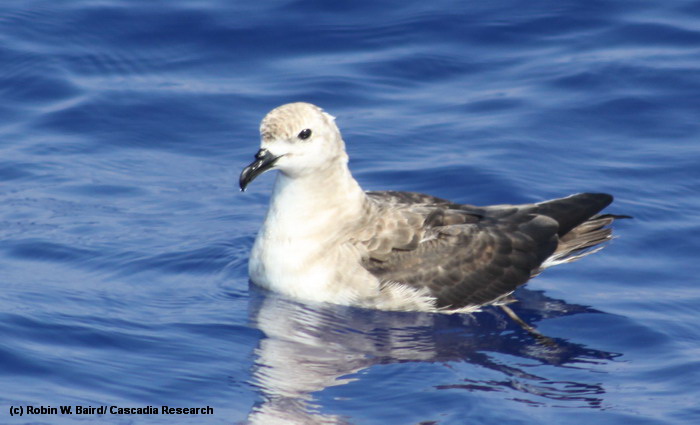
A pale morph Kermadec petrel off Kona, October 28 (with thanks to Pete Donaldson, Alvaro Jarmillo and Sophie Webb for species confirmation). Photo by Robin Baird. This is our first sighting of this species in Hawai‘i. For more information on this species go to the Birds of Hawai‘i page of the Bishop Museum.
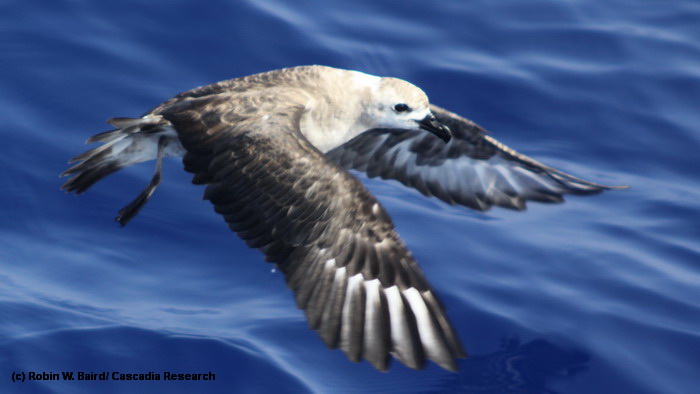
Another photo of Kermadec petrel off Kona, October 28. Photo by Robin Baird.
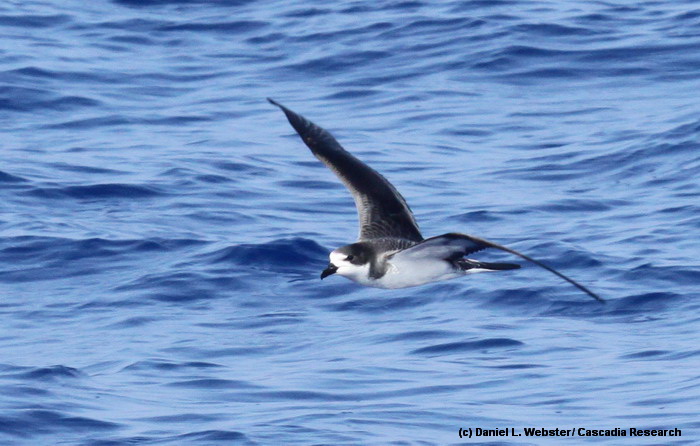
Hawaiian petrel off Kona, October 28. Photo by Daniel Webster.
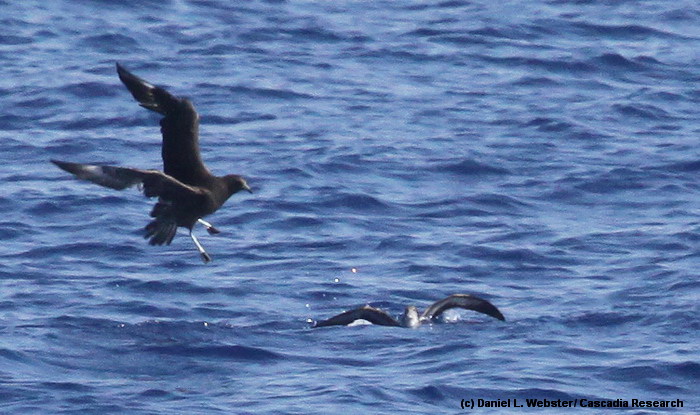
A dark-phase Pomarine Jaeger harassing a Wedge-tailed Shearwater to steal prey, October 28. Photo by Daniel Webster. Thanks to Alvaro Jarmillo for species confirmation.
October 27 update
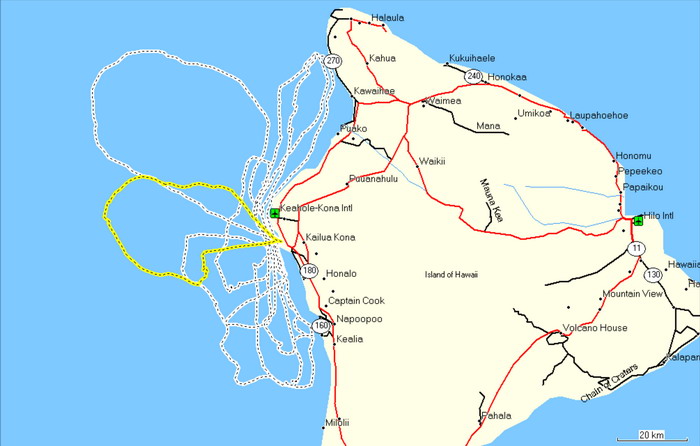
Today we covered 140 kilometers of trackline making it out to about 45 kilometers offshore of the island, over waters about 5,000 m deep. A quiet day on the water, with two sightings of pantropical spotted dolphins. As has been the case over the last few days, the satellite tagged Pseudorca remained north of our study area until well after we were back into the harbor. The map above shows all our tracklines over the last nine days, with today’s trackline in yellow.
October 26 update
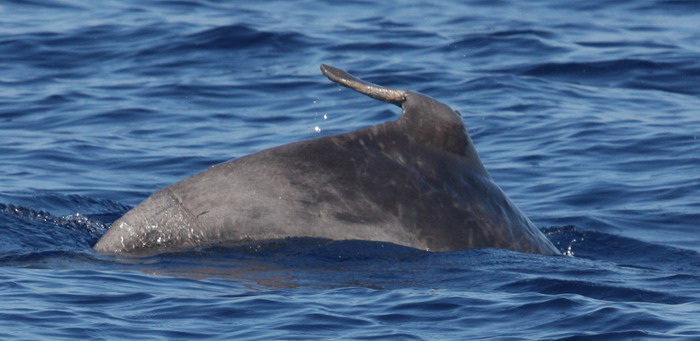
A common bottlenose dolphin with a damaged dorsal fin. Photo by Greg Schorr. Our first sighting of this individual was in 2002.
Today we went far to the north in the hopes of finding the group of Pseudorca that have been around the north end of the island. While the tagged whale had come south into our study area in the early evening of October 25th, by the morning they were back to the northeast of the island. We did have a productive day of sightings, with four species: short-finned pilot whale, pantropical spotted dolphin, common bottlenose dolphin and dwarf sperm whale.
October 25 update

A mother and calf short-finned pilot whale. Photo by Robin Baird.
Sadly Cuvier’s beaked whales are no longer our most frequently encountered species for the trip! Today we encountered a group of pantropical spotted dolphins and two groups of short-finned pilot whales. We deployed a satellite tag on one individual in each of the two groups of pilot whales. These satellite tags not only give location information but also record and transmit dive data, the first of these tags that we have deployed.
Meanwhile the closest satellite tagged Pseudorca remained out of our study area again today, but is still off the north end of the island, with the other Pseudorca groups off O‘ahu and Penguin Bank. The tagged Cuvier’s beaked whale and sperm whale continue to remain near South Point.
October 24 update
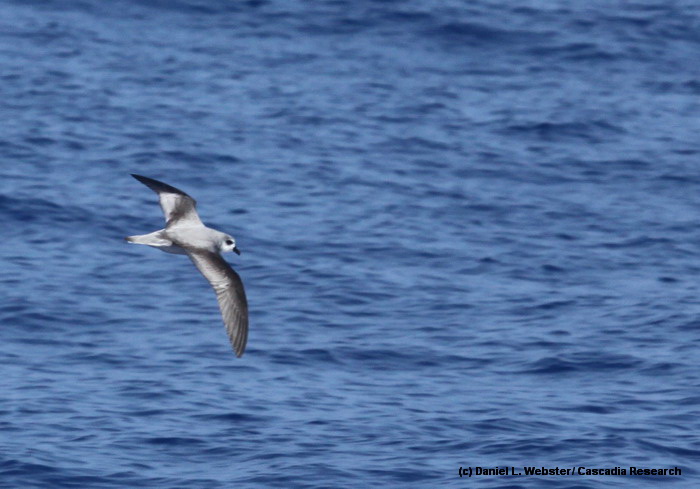
A Black-winged Petrel, October 24. Photo by Daniel Webster.
Today we covered 182 kilometers over a broad area to the northwest of the island, as far as about 60 kilometers offshore. The closest satellite tagged Pseudorca remained to the northeast of the island throughout most of the day (only showing up to the south well after we were back at the harbor!). Although conditions were great (mainly Beaufort 1 and 2) we had no sightings of whales or dolphins today. Today we had our first sighting of a Hawaiian petrel and numerous sightings of Black-winged Petrels as well as Leach’s Storm Petrels. We are still getting multiple locations each day from all five tagged Pseudorca as well as the sperm whale and Cuvier’s beaked whale.
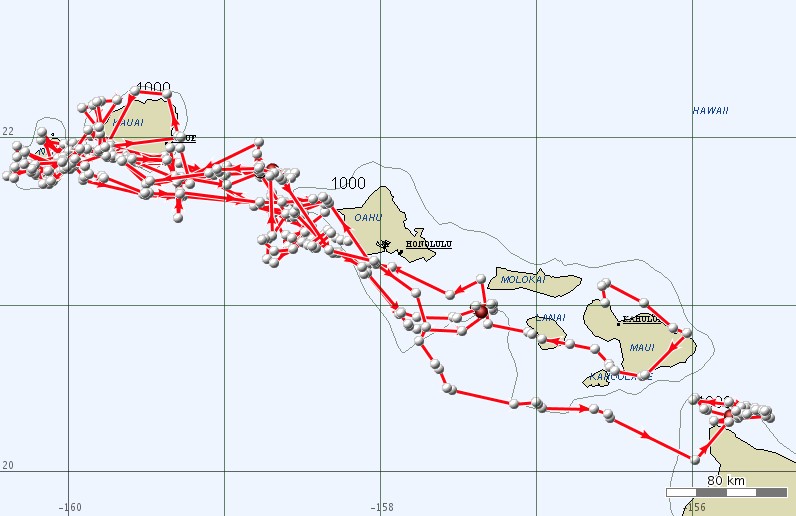
A map showing movements of five satellite tagged Pseudorca, as of the morning of October 24th. This map shows the movements of two groups over 10 days and the third group (with just one individual) over 9 days. These locations have not yet gone through a ‘speed filter’ and post-processing of the locations from ARGOS, so exact locations may change slightly.
October 23 update
A good day on the water. We re-deployed the HARP this morning, and will recover it in mid-December on our next trip out. The HARP will be recording up to ~100 kHz continuously for the next two months.

Re-deploying the HARP, October 23rd. Photo by Daniel Webster.
With two sightings today, our most frequently encountered species in the first five days of this field project is Cuvier’s beaked whale (with three sightings,compared to two for short-finned pilot whale and two for bottlenose dolphin). Sadly this trend is unlikely to continue for long.
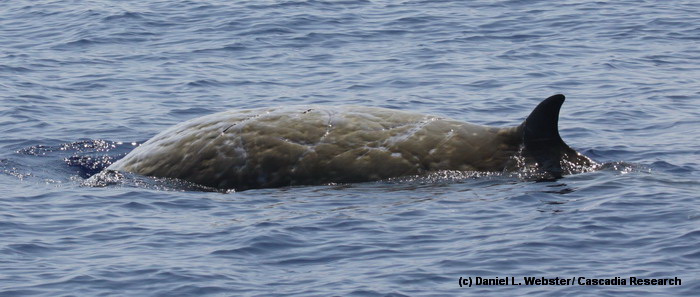
An adult male Cuvier’s beaked whale, October 23rd. Photo by Daniel Webster. This individual has been previously documented three times off the island of Hawai‘i in 2006, and was in a group of three (with two adult females, see below). Note the extensive linear scaring caused by interactions with other male Cuvier’s.
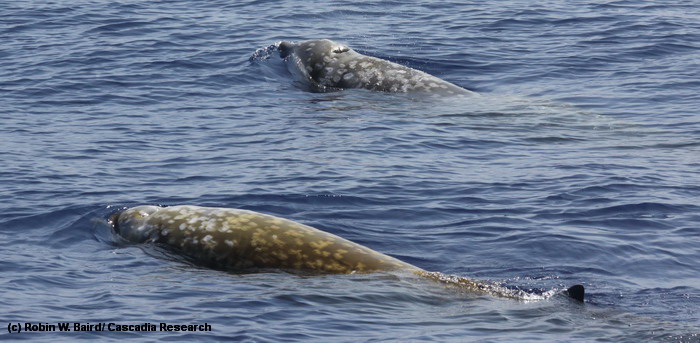
Two adult female Cuvier’s beaked whales, October 23rd. Photo by Robin Baird. Both of these females have been documented numerous times in our study area, one in 2004, 2006, 2008, and earlier in 2009, and the other in 1991, 1994, 1995, and 2006. Although these individuals have numerous oval scars caused by cookie-cutter sharks, they lack the linear scars seen on adult males. For more information on Cuvier’s beaked whales see our beaked whale page.
October 22 update
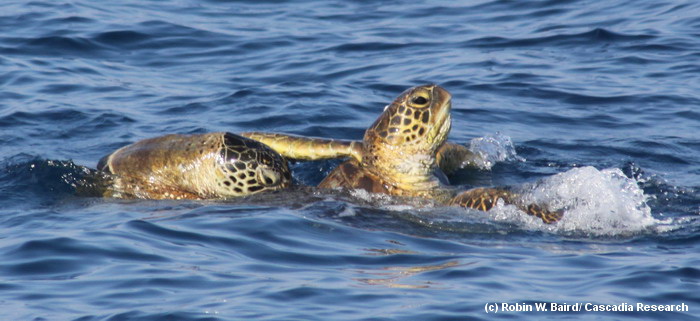
Two green sea turtles mating, October 22nd. Photo by Robin Baird. Green sea turtles nest primarily in the northwest Hawaiian Islands and it is quite unusual to see mating behavior off the island of Hawai‘i.
The closest tagged Pseudorca remained northeast of the island out of our range today, so we surveyed offshore to the west. Early in the day we encountered our eighth species of odontocete in four days, a group of pilot whales.
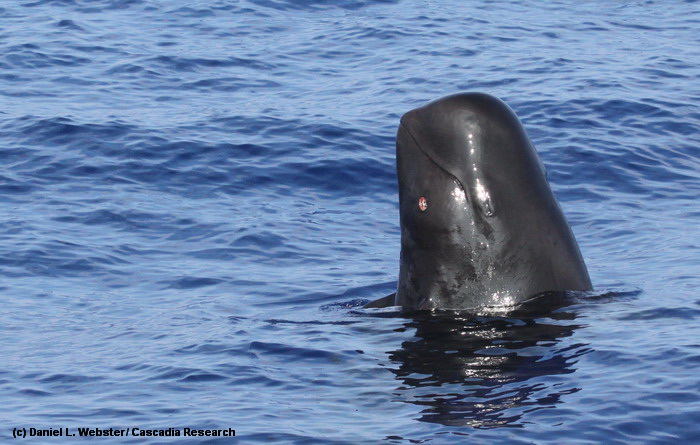
Spyhopping pilot whale, October 22nd. Photo by Daniel Webster. This individual has a partially healed bite wound on the lower jaw from a cookie-cutter shark.
We also collected a large squid and encountered our ninth species for the trip, a Cuvier’s beaked whale.
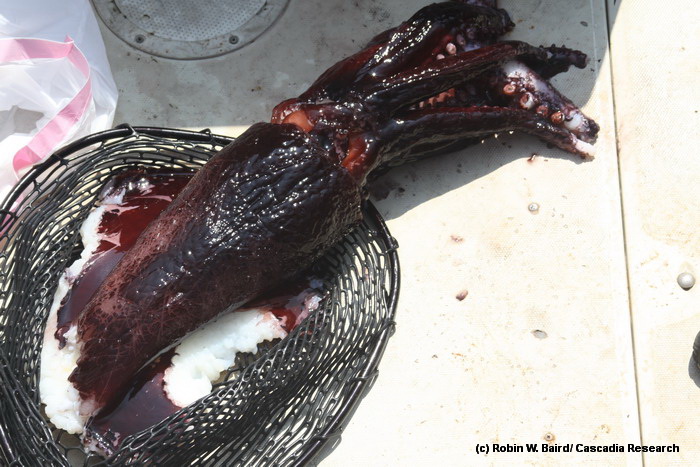
Squid collected October 22nd. Photo by Robin Baird.
October 21 update
Before leaving we checked the ARGOS satellite locations from our tagged Pseudorca – one had approached close to the island in the night and we headed north towards the earlier location.
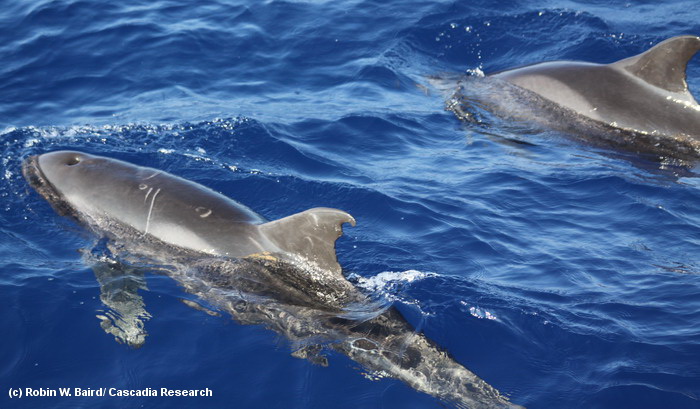
Two pygmy killer whales bowriding on our research vessel, October 21. Photo by Robin Baird.
A nice way to start our third day on the water, a group of three very friendly pygmy killer whales. The individual in the foreground is HIFa001 in our catalog, first documented off the island in the early 1980s and seen regularly since. These can be distinguished as pygmy killer whales, rather than melon-headed whales, by the clear demarcation between the dark dorsal cape and the lighter grey lateral pigmentation, as well as by the widely-spaced paired white scars. We received updated locations of the tagged Pseudorca from about 7 AM, located north of the north tip of the island, so continued to go north hoping the group was spread over a wide area or they turned south back into our study area.
 A group of melon-headed whales, October 21. Photo by Daniel Webster.
A group of melon-headed whales, October 21. Photo by Daniel Webster.
A few kilometers south of a windline we found a group of about 50 melon-headed whales, and were able to get identification photos of most or all individuals present. Updated satellite locations on the Pseudorca showed they had not turned south so we returned to south of the harbor where we recovered the HARP that had been deployed there several months earlier.
October 20 update
Today was our second day on the water. Our first day started with the usual minor boat problems, but we were able to cover over 120 kilometers off the west side of the island in fairly good sea conditions. The highlights of the day were the collection of our first squid sample and sightings of a South Polar Skua and a Black-winged Petrel. Cetaceans were sparse (only spinner dolphins off Honokohau Harbor).
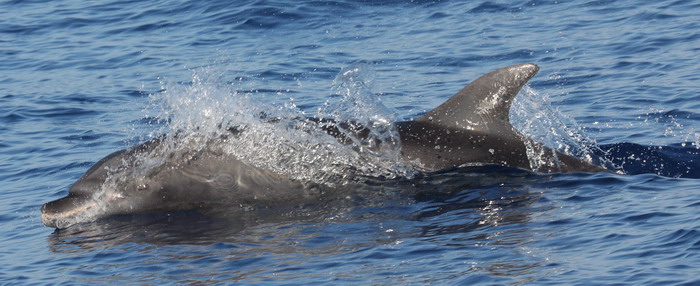
A bottlenose dolphin off Kona, October 20, 2009. Photo by Greg Schorr.
Our second day on the water was much more productive. We were checking the locations of one of our satellite tagged Pseudorca – at 2 AM it was west of Kaho‘olawe heading east (see map below) so if it continued to move quickly it might make it to Kona today.
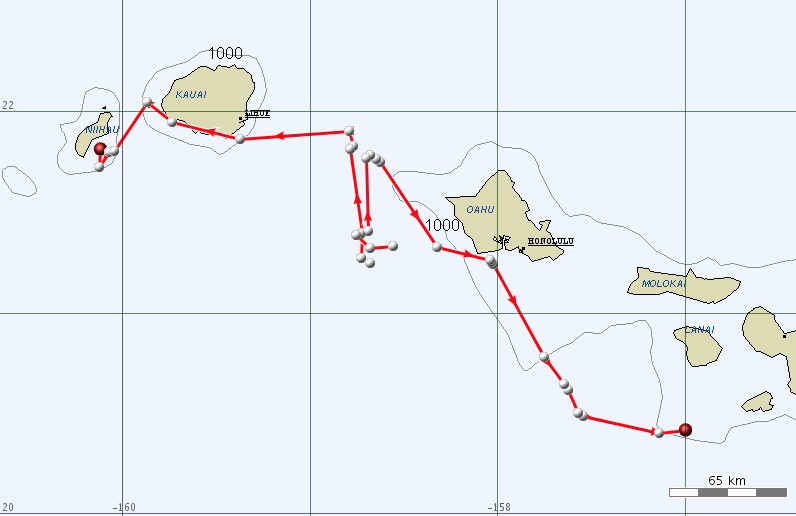
Map showing the movements of two satellite tagged Pseudorca from October 17 through the early morning of October 20th. The individual moving east was tagged October 17th off O‘ahu in the same group as the individual currently off Ni‘ihau.
Although we did not find the false killer whales, we encountered a group of bottlenose dolphins (see above) and pantropical spotted dolphins, and were able to get identification photos of most of the bottlenose dolphins. We encountered our fourth species of odontocete for the trip a few hours later in deeper water (~3000 m) offshore, a dwarf sperm whale.

An adult dwarf sperm whale logging at the surface, October 20, 2009. Photo by Greg Schorr. We were able to re-locate this individual after a 16 minute long dive, and we collected a slough-skin sample from it. Dwarf sperm whales are typically too difficult to approach closely enough to biopsy, so being able to collect sloughed skin from this individual was quite exciting.
The highlight of the day was an encounter with about 11 sperm whales. We were able to collect two biopsy samples for genetic studies as well as studies of pollutants.

Sperm whales off Kona, October 20, 2009. Photo by Daniel Webster. We were also able to deploy a satellite tag on one individual, the first time we’ve satellite tagged a sperm whale in Hawai‘i. We will post maps here of movements of this group.
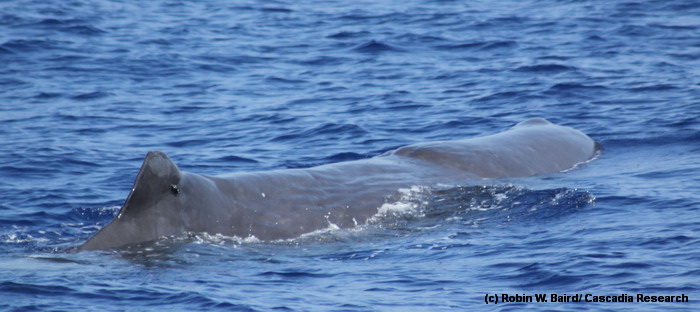
Sperm whale with satellite tag on the base of the dorsal fin. Photo by Robin Baird.
October 19 update
The O‘ahu field effort finished up on October 17th and was extremely productive, with additional sightings of melon-headed whales, short-finned pilot whales, rough-toothed dolphins and spinner dolphins, as well as sightings of striped dolphins, bottlenose dolphins, pantropical spotted dolphins, dwarf sperm whales, and Blainville’s beaked whales. As well as the false killer whale tagged October 5th they were able to deploy four more satellite tags on false killer whales, two in sub-groups associated with the first tagged false killer whale and two in a different group located 200 kilometers away at the time. This is the first time we have had satellite tags out on more than one group of false killer whales at a time so will allow us to get an idea of how variable group travel patterns are and how groups interact.
Today will be our first day on the water off Kona.
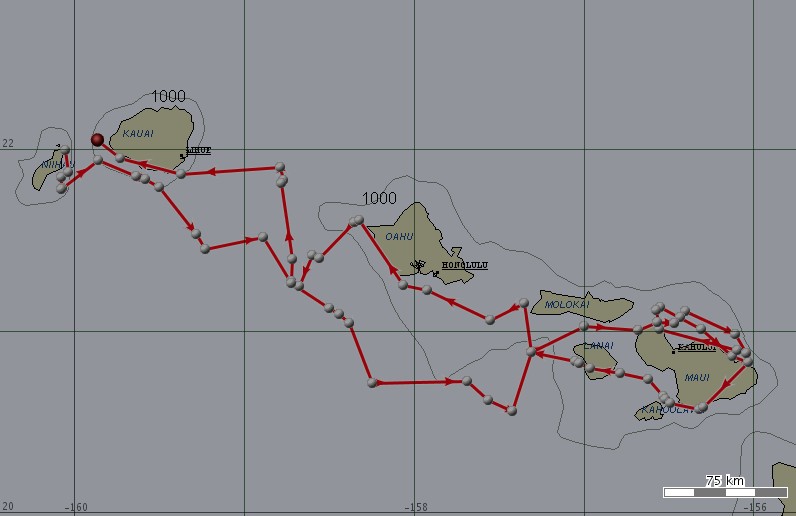
Map showing movements of the satellite tagged false killer whale from October 8th through the morning of October 19th.
October 7 update
The false killer whale tagged off O‘ahu, October 5th, 2009 has moved to the west of Kaua‘i. All the false killer whales that we’ve previously satellite tagged have been off the island of Hawai‘i, and although one individual did move as far as Kaua‘i, this tag deployment should give us a much better idea of habitats of false killer whales in the western main Hawaiian Islands.
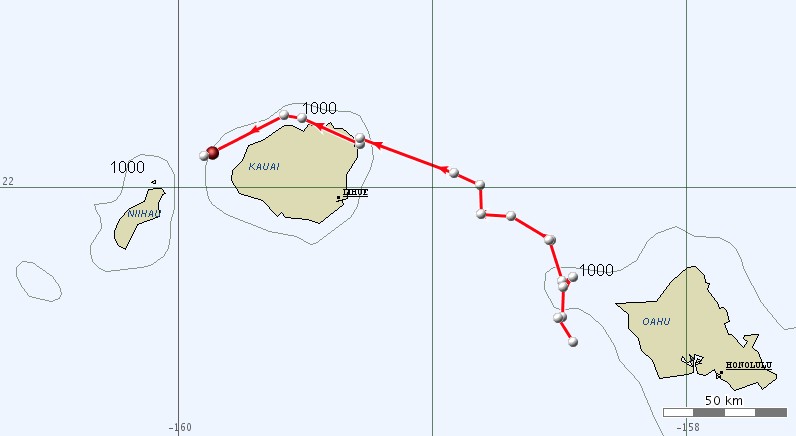
Map showing movements of the satellite tagged false killer whale from October 5th through the morning of October 7th.
October 5 update
The first four days of field efforts off O‘ahu have been quite productive, with encounters with melon-headed whales, rough-toothed dolphins, pantropical spotted dolphins, spinner dolphins, short-finned pilot whales and, on October 5th, a group of false killer whales.
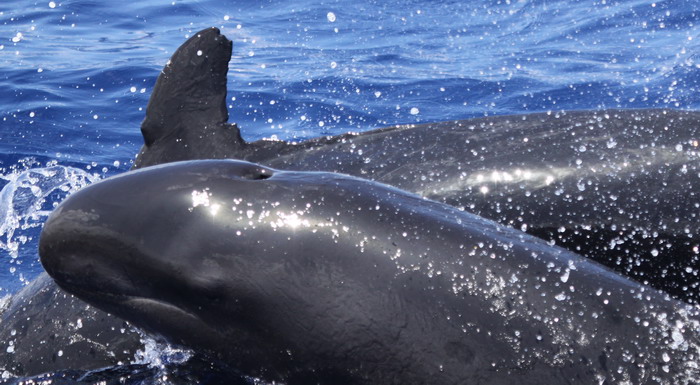 |
False killer whales off O‘ahu, October 5th, 2009. Photo by Marie Hill/Pacific Islands Fisheries Science Center. |
This group is from the island-associated population of false killer whales. As well as two biopsy samples (for genetics and pollutant analyses), one satellite tag was deployed to examine movements.
 |
Melon-headed whale leaping off O‘ahu, October 2nd, 2009. Photo by Mark Deakos/Pacific Islands Fisheries Science Center. |
Photos on this page taken under NMFS Scientific Research Permits (Nos. 731-1774 and 774-1714). All photos are copyrighted and should not be used without permission.